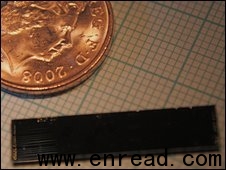| ||||||||||||||||||||||||||||||||||||||||||||||||||||||||||||||||||||||||
|
Researchers have devised a penny-sized silicon1 chip that uses photons to run Shor's algorithm - a well-known quantum approach - to solve a maths problem. 研究人员设计出一个便士大小的硅晶片,利用量子运行肖尔算法——一种著名的量子算法——来解决一个数学问题。  Chips like this one could form the basis for future optical computers The algorithm(算法) computes2 the two numbers that multiply together to form a given figure, and has until now required laboratory-sized optical computers. This kind of factoring is the basis for a wide variety of encryption schemes(加密机制). The work, reported in Science, is rudimentary(基本的) but could easily be scaled up to handle more complex computing3. Shor's algorithm and the factoring of large numbers has been a particular case used to illustrate4 the power of quantum(量子) computing. Quantum computers exploit the counterintuitive(违反直觉的) fact that photons(光子) or trapped atoms can exist in multiple states or "superpositions" at the same time. For certain types of calculations, that "quantum indeterminacy" gives quantum computers a significant edge. While traditional or "classical" computers find factoring large numbers impracticably time-consuming, for example, quantum computers can in principle crack the problem with ease. That has important implications for encryption methods based on factoring, such as the "RSA" method that is used to make transactions on the internet more secure. 'Important step' Optical computing has been touted5 as a potential future for information processing, by using packets of light instead of electrons as the information carrier. But these packets, called photons, are also endowed with the indeterminate(不明确的,含混的) properties that make them quantum objects - so an optical computer can also be a quantum computer. In fact just this kind of photon-based quantum factoring has been accomplished6 before, but the ability to put the heart of the machine on a standard chip is promising7 for future applications of the idea. "The way people used to make this kind of circuit consumed square metres of laboratory space and took graduate students many months to align," said Jeremy O'Brien, the University of Bristol researcher who led the work. "Doubling the complexity8 of the circuit often times turns it from being a difficult task to a practically impossible one, whereas for us to double the complexity it's really straightforward," he told BBC News. The Bristol team's approach makes use of waveguides - channels etched(被侵蚀的,风化的) into the chips that provide a path for the photons around the chips like the minuscule9(草写小字的) wires in conventional electronics. While Professor O'Brien said he is confident that such waveguides are the logical choice for future optical quantum computers, he added that there is still a significant amount of work to do before they make it out of the laboratory. "To get a useful computer it needs to be probably a million times more complex, so a full-scale useful factoring machine is still at least two decades away," he said. "But this is one important step in that direction." 点击  收听单词发音 收听单词发音
|
||||||||||||||||||||||||||||||||||||||||||||||||||||||||||||||||||||||||
- 发表评论
-
- 最新评论 进入详细评论页>>



